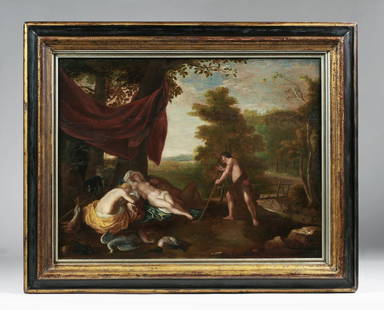
Madrid master; c.1660. "Virgin in prayer". Oil on
Similar Sale History
View More Items in PaintingsRelated Paintings
More Items in Paintings
View MoreRecommended Art
View More








Item Details
Description
Madrid master; c.1660."Virgin in prayer".Oil on canvas. Keep the original canvas.It has a new frame, with canvas extensions on the sides. Frame from the end of the 17th century in carved and gilded wood adapted.Measurements: 129.5 x 94 cm; 151.5 x 117.5 cm (frame).With great expressiveness and devotional passion, the author presents us with a work in which the figure of the Virgin stars in a scene filled with an impulse of rotundity and mystical impetus, where Mary is positioned as an imperturbable symbol of the Christian Faith. Represented in the center of the composition, adopting a posture of great dramatism, the Virgin directs one of her hands towards her chest, while she extends the other, opening her arm to the faithful. Her face, which is raised towards the sky, shows the ardors suffered by the Virgin, who, with her mouth half-open, reflects suffering as the mother of the savior. A face that defines the integrity of the work, and is very reminiscent of the face of the Immaculate Conception (ca.1660), made by Maestro Cerezo, which rests in the Prado Museum in Madrid. Technically, the broad but precise brushstroke, the mastery of shadows, and the composition bring this piece, not only to the aforementioned painter, Mateo Cerezo, but also to Van Dyck, as can be seen in the work of Santa Rosalia, or La Caridad, both located in the Prado Museum, or La Virgen con el Niño (1621-1622), which is in the Museo Cerralbode Madrid, which was attributed to Mateo Cerezo, until 1927. The comparisons between both painters are frequent, since Mateo Cerezo, developed his painting in the environment of Madrid, where it is probable that he had the opportunity to study the works of the Flemish master, applying to his technique, pictorial resources typical of the works of Van Dyck. In addition, it is worth mentioning that Miranda Carreño, Cerezo's teacher, also had a great influence of Van Dyck in his painting, both in his palette and in the looseness and lightness in the application of the brushstrokes, characteristics that can be appreciated in this work.The Madrid school arose around the court of Philip IV first and Charles II later, and developed throughout the seventeenth century. Analysts of this school have insisted on considering its development as a result of the agglutinating power of the court; what is truly decisive is not the place of birth of the different artists, but the fact that they were educated and worked around and for a nobiliary and religious clientele located next to the royalty. This allows and favors a stylistic unity, although the logical divergences due to the personality of the members can be appreciated. In its origin, the Madrid school is linked to the rise to the throne of Philip IV, a monarch who made Madrid, for the first time, an artistic center. This meant an awakening of the nationalist conscience by allowing a liberation from the previous Italianizing molds to jump from the last echoes of Mannerism to Tenebrism. This will be the first step of the school, which in a gradual sense will walk successively until the attainment of a more autochthonous baroque language and linked to the political, religious and cultural conceptions of the monarchy of the Austrias, to go to die with the first shoots of the rococo that are manifested in the production of the last of its representatives, A. Palomino. The techniques most used by these painters were oil and fresco. Stylistically, they start from a naturalism with a notable capacity for synthesis to opportunely lead to the allegorical and formal complexity characteristic of the decorative baroque. These artists show a great concern for the studies of light and color, as we see here, highlighting at first the games between extreme tones typical of tenebrism that later will be replaced by a more exalted and luminous colorism. They receive and assimilate Italian, Flemish and Velázquez influences.
Buyer's Premium
- 23%
Madrid master; c.1660. "Virgin in prayer". Oil on
Estimate €35,000 - €40,000
2 bidders are watching this item.
Get approved to bid.
Shipping & Pickup Options
Item located in Barcelona, barcelona, esSee Policy for Shipping
Payment

TOP




























![Old Master 16th-17th c, Christ, Oil on Copper: An Old Master 16th-17th c., Portrait of Christ with Crown of Thorns, oil on copper, unsigned, probably Italian, possibly Spain. [ELLY8001] (TC) Dimensions: 4.5x4.5, framed 8.25x8.25](https://p1.liveauctioneers.com/3975/109984/56432758_1_x.jpg?height=310&quality=70&version=1506708232)












































